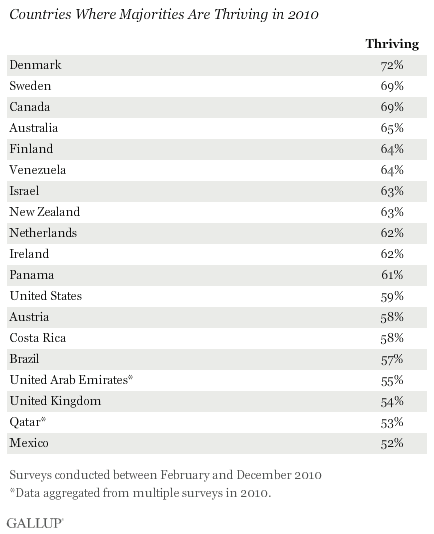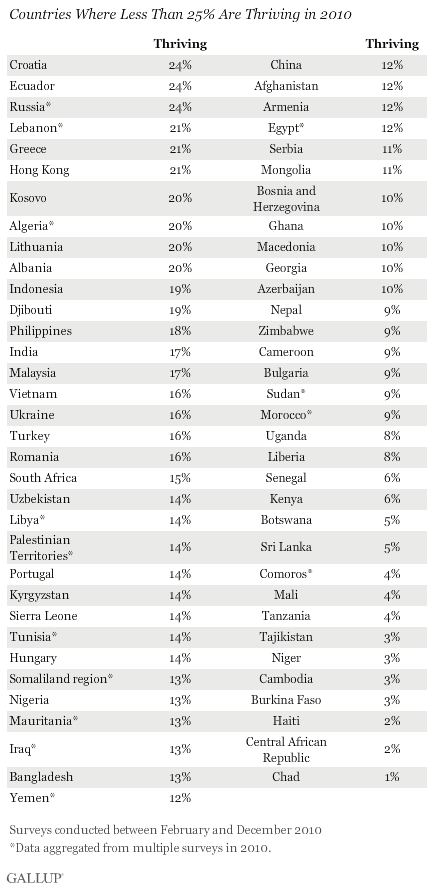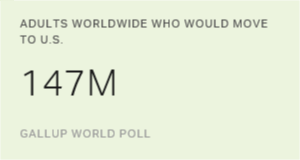WASHINGTON, D.C. -- Gallup's global well-being surveys in 2010 reveal that a median of 21% across 124 countries were "thriving" last year, based on how people rated their lives at the current time and their expectations for the next five years. This is unchanged from a median of 21% in 2009. The percentage rating their lives well enough to be considered thriving ranged from a high of 72% in Denmark to a low of 1% in Chad.
Gallup classifies respondents' well-being as "thriving," "struggling," or "suffering," according to how they rate their current and future lives on a ladder scale with steps numbered from 0 to 10 based on the Cantril Self-Anchoring Striving Scale. People are considered thriving if they rate their current lives a 7 or higher and their lives in five years an 8 or higher.
Majorities of residents in 19 countries -- mostly in Europe and the Americas -- rated their lives well enough to be classified this way. Denmark, along with Sweden (69%) and Canada (69%), led the list, which is largely dominated by more developed and wealthier nations, as expected given the links between well-being and GDP. The U.S. falls somewhat near the middle of the pack, with 59% of Americans thriving.

Outside of this group, much of the world was not doing nearly as well. In 67 countries, less than 25% of people were thriving. Countries on this list hailed from all regions, but thriving was generally lowest in sub-Saharan Africa. The median thriving percentage in this region was 8%. No country in sub-Saharan Africa had a thriving percentage higher than 19%, underscoring the entire region's development challenges.

In other regions, the divides remained great in how people evaluated their lives. In the Americas, where the median thriving percentage is the highest in the world at 39%, thriving ranged from a high of 69% in Canada to a low of 2% in earthquake-ravaged Haiti. In Europe, where the median thriving percentage was lower, but still higher than average at 28%, thriving ranged from a high of 72% in Denmark to a low of 9% in Bulgaria.
A median of 20% in the Middle East and North Africa region were thriving. Nearly two in three (63%) were thriving in Israel -- the highest score in the region -- as were more than half of respondents in the relatively wealthy United Arab Emirates and Qatar. Small minorities -- one in seven or fewer -- were thriving in Tunisia, Yemen, Egypt, and Morocco, which provides some evidence of the underlying discontent that bubbled over in late 2010 and early 2011.
In Asia, where a median of 17% were thriving, there were large gaps between developed and developing Asian countries. Thriving was higher than 60% in Australia (65%) and New Zealand (63%) and as low as 3% in Tajikistan and Cambodia.
Little Progress in 2010
Global well-being improved little between 2009 and 2010, remaining relatively steady when Gallup groups all these countries into four major global regions: Asia, Africa, the Americas, and Europe. In Europe, the median percentage thriving in 2009 was 25%, remaining essentially unchanged in 2010 at 28%. Ten percent in Africa were thriving in 2009, compared with 9% in 2010. In Asia, the median remained flat at 18% each year. In the Americas, the 42% thriving in 2009 wasn't significantly different from the 39% thriving in 2010.
Implications
Gallup's global well-being data underscore the diversity of development challenges worldwide. As the uprisings in Tunisia and Egypt showed earlier this year, leaders should not rely on GDP alone as an indicator of how well their countries and their citizens are doing. Monitoring and improving behavioral economic measures of well-being are important to helping leaders better the lives of all their residents.
See the complete data for all countries on page 2.
For complete data sets or custom research from the more than 150 countries Gallup continually surveys, please contact SocialandEconomicAnalysis@gallup.com or call 202.715.3030.
Survey Methods
Results are based on face-to-face and telephone interviews with approximately 1,000 adults per country, aged 15 and older, conducted in 2010 in 124 countries. Results in Russia, Tunisia, Egypt, the United Arab Emirates, Libya, Saudi Arabia, Qatar, Djibouti, Sudan, Lebanon, Morocco, Jordan, the Palestinian Territories, Bahrain, Yemen, Comoros, Somaliland region, and Iraq are based on data aggregated from multiple surveys. For results based on the total samples, one can say with 95% confidence that the maximum margin of sampling error ranges from ±1.7 percentage points to ±5.7 percentage points. The margin of error reflects the influence of data weighting. In addition to sampling error, question wording and practical difficulties in conducting surveys can introduce error or bias into the findings of public opinion polls.
For more complete methodology and specific survey dates, please review Gallup's Country Data Set details.

